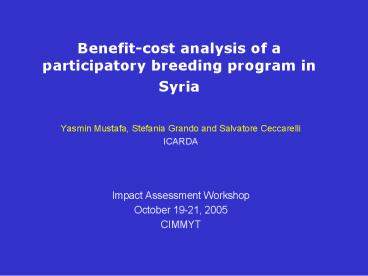Benefitcost analysis of a participatory breeding program in Syria - PowerPoint PPT Presentation
1 / 18
Title:
Benefitcost analysis of a participatory breeding program in Syria
Description:
Barley is the second most important crop in Syria.It is grown as a feed crop in ... a participatory plant breeding programs as they are implemented in Syria. ... – PowerPoint PPT presentation
Number of Views:289
Avg rating:3.0/5.0
Title: Benefitcost analysis of a participatory breeding program in Syria
1
Benefit-cost analysis of a participatory breeding
program in Syria
- Yasmin Mustafa, Stefania Grando and Salvatore
Ceccarelli - ICARDA
- Impact Assessment Workshop
- October 19-21, 2005
- CIMMYT
2
Benefit-Cost Analysis of a Participatory breeding
in Syria
- Introduction
- Participatory plant breeding (PPB)
- Methodology
- Benefits on program level on farm level
- Costs on program level on farm level
- Results conclusions
3
Introduction
- Barley is the second most important crop in
Syria.It is grown as a feed crop in rainfed area,
200-350mm of rainfall - Most barley is grown in marginal environment
where no other crop can be grown. - PPB started at 1996 on 7 villages in Syria, and
expand to 25 villages in 7 provinces that cover
90 of barley growing area. - The sample included 69 farmers who are
participating in the PPB program, 69 farmers
participated in variety selection, and 69 non
participant farmers.
4
Advantages of PPB
- Offering farmers the possibility to decide which
varieties - suit better their needs and conditions
- without posing risks to livelihoods.
- Increasing the probability and speed of adoption
- Increasing efficiency and effectiveness of the
breeding program - Increasing feed backs from
- farmers to researchers
- Enhance the human capital
- of farming communities
- Contribute to yield stability
- by providing more
- adaptable varieties
5
Features of PPB in Syria
- Based on the following two principles
- 1. The trials are grown in farmers fields using
farmers agronomic practices. - 2. Selection is conducted by farmers in farmers
fields, so that farmers are the key decision
makers. - Farmers participate in initial, advanced, and
elite trials. - PPB is implemented in 25 communities in 7
provinces. - Current program was started in 2000.
- 11 varieties have been already released in three
communities.
6
Percentage of barley area and barley farmers
under improved varieties.
- F, is percentage of farmers grow new varieties.
- A, is percentage of area in new varieties.
7
A conventional and a participatory plant breeding
programs as they are implemented in Syria.
Conventional Plant Breeding
Participatory Plant Breeding
Year 1
Crosses
Crosses
On-Station
Year 2
F1
F1
Year 3
F2 Bulks
F2 Bulks
On-Station
Farmer Initial Trials (FIT)
Barley Initial Trial (BIT)
Year 4
Farmer Advanced Trials (FAT)
Barley Preliminary Trials (BPT)
Year 5
On Farm
Farmer Elite Trials (FET)
Barley Advanced Trials (BAT)
Year 6
Adoption Release
Year 7
On-Farm Trials (OFT)
On Farm
Year 8
On-Farm Trials (OFT)
Year 9
On-Farm Trials (OFT)
8
A Representative Module of Farmers Participation
in PPB
- The following module is taken from Suran
community in Hama Province
9
Adoption in PPB and CPB
Rate of adoption
Ceiling of adoption
PPB Research Costs
Research benefits
Start of Diffusion
Time
0
Dissemination costs
6 9
CPB Research Costs
10
Gross Economic Benefit Model
- m n
- GEB ? ?? Aj Iij Yij Pij
? - j1 I1
- Where
- Pij pij / E
- Yij yij - Lij
11
Amount of available seeds, seed rates, planted
area, average yield, gain in yield and barley
production and gross economic benefits for PPB.
12
Benefit and cost on farm level
- Benefit A Y P
- Cost there is no difference between costs of the
two programs, because farmers use the same
agricultural practices in the two programs. - The only difference is the opportunity cost of
farmers participation (5 working days on average)
13
Intellectual Benefits to Farmers
- The knowledge that farmers get through their
participation in the program improves their
ability to make decisions regarding the variety
testing and selection. - About 31 of the interviewed farmers stated
that, PPB enhanced their experience in barley
production, as well as in agricultural in
general. - Nearly 44 of them said that they gained new
knowledge in variety selection through their
participation in the evaluation and selection
process. - 21 stated that their knowledge increased as a
result of their interaction with other farmers,
and 27 that their knowledge increased as a
result of their interaction with breeders. - The PPB program has a positive impact on the
economic status and the livelihood of 65 of
participant farmers. - About 31 of the interviewed farmers stated that,
even if the PPB research will end, they would
keep practicing what they have learned about
plant breeding and selection. They also assured
that they would protect the seed of the new
variety, and would keep looking for good
varieties with other farmers, and plant them. - only 7 of the interviewed farmers believed that
farmers who got the selected varieties should
keep the benefits for themselves, while 93
believed that benefit should be distributed at
community level.
14
Costs of Conventional and Participatory Plant
Breeding Program at ICARDA (US )
15
Time Allocation for PPB and CPB ()
- Most of research time is allocated to CPB
- PPB is time-saving strategy due to wide farmers
participation - RAs allocate more time than others in PPB
16
Benefit-cost analysis
- CPB program
- Present value of cost (2000-04) is 357,390 US
- Present value of benefits (2000-04) is 31million
US. - Benefit-cost ratio is 68
- PPB program
- Present value of cost (2000-04) is 363,902 US
- Present value of benefits for the first season
for two location only is 1.85 million US. - Benefit-cost ratio is 5.1
17
ICARDA human and financial investment in barley
breeding programs
18
Cumulative Area in Improved Varieties

